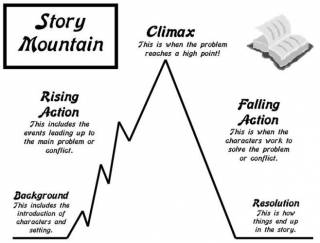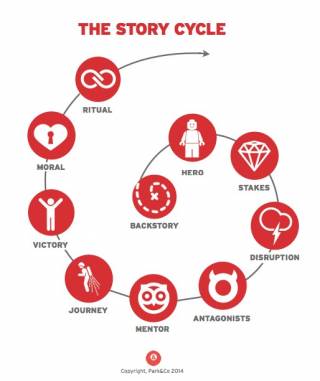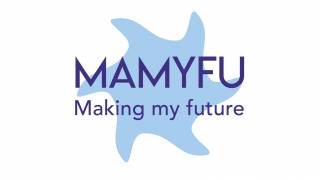Storytelling is the interactive art of using words and actions to reveal the elements and images of a story while encouraging the listener’s imagination.
Storytelling involves a two-way interaction between a storyteller and one or more listeners. The responses of the listeners influence the telling of the story. In fact, storytelling emerges from the interaction and cooperative, coordinated efforts of teller and audience.
In particular, storytelling does not create an imaginary barrier between the speaker and the listeners. This is part of what distinguishes storytelling from the forms of theatre that use an imaginary “fourth wall”.
Storytelling presents a story. Storytelling always involves the presentation of a story – a narrative. Many other art forms also present story, but storytelling presents it with the other four components. Every culture has its own definition of story. What is recognized as a story in one situation may not be accepted as one in another. Some situations call for spontaneity and playful digression, for example; others call for near-exact repetition of a revered text. Art forms such as poetry recitation and stand-up comedy sometimes present stories and sometimes don’t. Since they generally involve the other four components, they can be regarded as forms of storytelling whenever they also present stories.
In storytelling, the listener imagines the story. In most traditional theatre or in a typical dramatic film, on the other hand, the listener enjoys the illusion that the listener is actually witnessing the character or events described in the story.
The overview of compiling a story:
Storytelling follows the idea and words like first, next, then, and finally.
Like stories, every day has a beginning, middle, and an end. Have students describe their daily activities in terms of beginning, middle and end:
- What is the beginning of the day?
- What is the middle?
- What is the end of the day?
- What do you do during each of these times of day?
Classical storytelling model

Source: https://coolerinsights.com/2009/06/once-upon-a-brand/brand-story-plot/

Source: https://businessofstory.com/story-cycle/
Creating a story involves these five steps:
- Determine who your audience is and find out as much as you can about them.
- Figure out what you want them to do – buy your product, work more efficiently, follow you into battle. This is the goal.
- Think through the challenges that may get in the way of the goal – lack of budget, outdated technology, distrust.
- Find a character who overcame the challenge – by appealing to value over price, working around technology, discovering common ground.
- Make sure there’s a resolution to your story.
The 12 steps of storytelling are:
1 – Ordinary World.
Most dramatic stories are a spin on the classic fish out of water tale. Something happens which takes your hero out of his ordinary world. It’s your job to first set up that ordinary world before an unforeseen event happens that hurls your protagonist out of their comfortable surroundings.
2 – Call to Adventure
This is where the problem is presented to your heroine. She can no longer stay in her comfortable world. The stakes are high. The goal is set. The challenge established.
3 – Refusal
Our hero is reluctant. They know what must be done but don’t want to leave their comfortable world. A friend or mentor steps in to set them on their path. Fear is the driving emotion of the refusal. It could be just fear of change, or consequences.
4 – Mentor
The mentor may not be immediately recognizable, but establishes a special bond with our hero. The mentor will persuade the hero, why they must undertake the journey.
5 – Threshold
Overcoming her fear and initial objections, your heroine commits to the journey. There is no going back now. She has stepped over the threshold and nothing will be the same again.
6 – Tests, Allies & Enemies
By crossing the threshold, your protagonist has entered a new world with new rules she must learn to survive. She’ll encounter new friends and enemies while coming to grips with her surroundings. Tests will reveal her true character.
7 – Inner Sanctum
Our hero finds himself in the most dangerous place in this new unknown world where the object of his journey is hidden. Our hero now must cross the second threshold. The hero now must confront death or incredible danger and seize her prize.
8 – Ordeal
Will our hero live or die? This is a crucial part, because the hero must ‘die’ to be ‘reborn’. Every drama must have a life or death moment. The stakes must be high to keep readers turning your pages.
9 – Reward
Our heroine has survived death, and taken the reward (physical or knowledge) she has searched so long for. There may also be love to sweeten the reward.
10 – Return
Our hero now has to return to the ordinary world. How has their ordeal changed them? They won’t get a clean run though, as some final trial or test will stand in the way of their homecoming.
11 – Resurrection
Our heroine isn’t home yet. There will be one final confrontation before returning to her safe, ordinary world. This may be a life and death struggle. A true final test of the new knowledge she has gained from her journey.
12 – Home
Our hero finally returns home, changed forever by the special knowledge she has gained on the journey. She has emerged the victor.

Source: https://scribbler.john-mendez.com/2020/07/03/on-pacing-and-structure-the-heros-journey-part-2/
Process includes:
Preparation: explaining the storytelling main structure. Discussion about the one´s day following the structure of the storytelling.
Creative writing session: Listen the music “The forgotten man” https://youtu.be/rhytOyFMIxI?list=RDrhytOyFMIxI. Imagine the world or the situation that the music is creating in your head.
Start the story. And suddenly it appeared… and continue to writing your first thought 30 minutes.
Discussion: Share your stories and discussion about the fantasy and the storytelling.
Resources:
https://storynet.org/what-is-storytelling/
http://citeseerx.ist.psu.edu/viewdoc/download?doi=10.1.1.464.7255&rep=rep1&type=pdf
https://sites.nasher.duke.edu/wordsandpictures/lesson-plan/storytelling-with-lines/
https://spinsucks.com/communication/creative-storytelling-process/
Ederi Ojasoo


